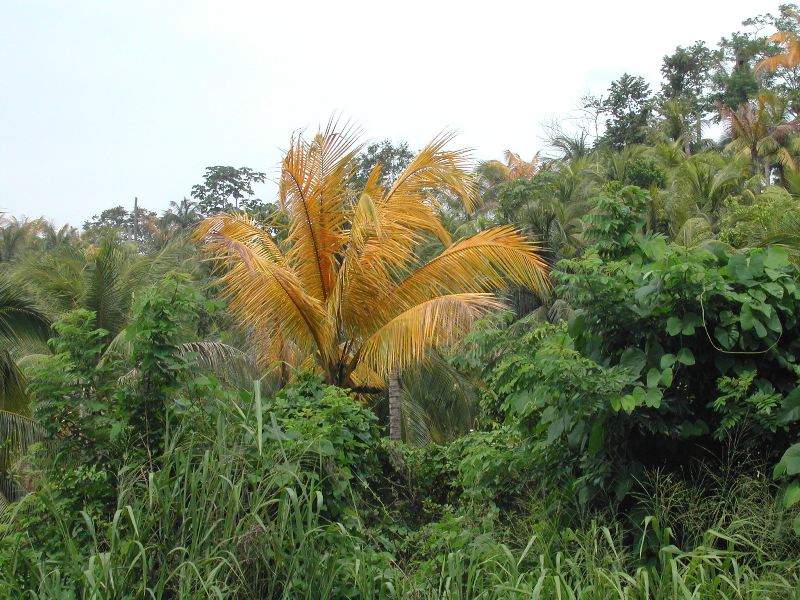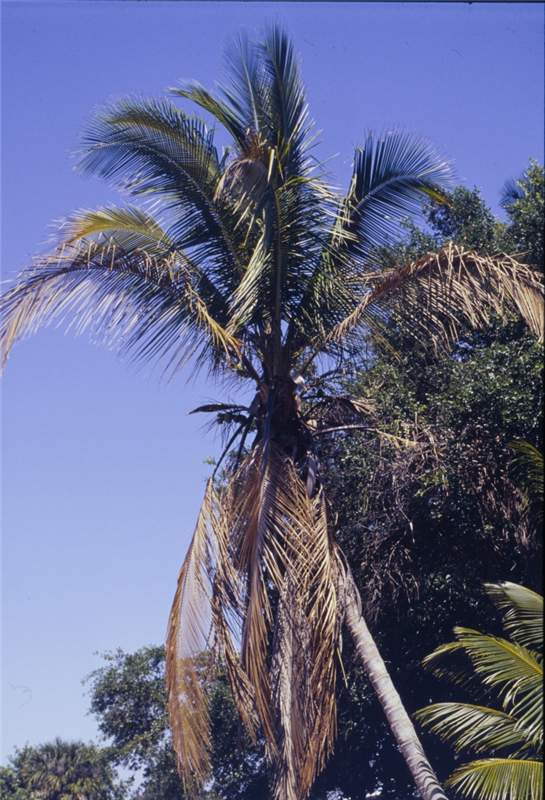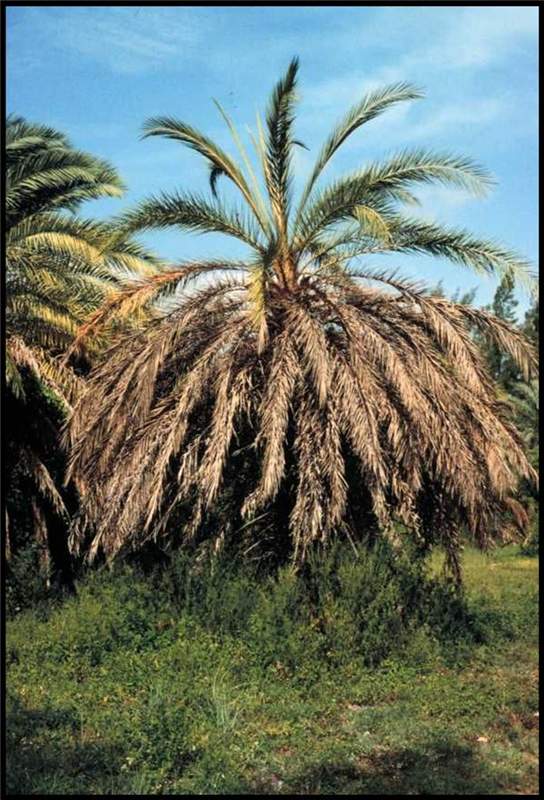Lethal Yellowing
|
Figure 1. Cocos nucifera in various stages of lethal yellowing disease development. Healthy palms are in the background. Palm in foreground is in early to mid-stages of the disease. Palm on the left has died but dead leaves are still attached to the trunk. Trunks without canopies died previously from LY. Photo by N. A. Harrison, University of Florida.
|
|
Figure 2. Leaf yellowing symptoms on Cocos nucifera. Photo by N. A. Harrison, University of Florida.
|
|
Figure 3. Cocos nucifera spear leaf is dying just as the last leaves are discoloring. Photo by M. L. Elliott.
|
|
Figure 4. The leaves of dwarf cultivars of Cocos nucifera affected by lethal yellowing usually do not turn yellow. Photo by N. A. Harrison, University of Florida.
|
|
Figure 5. Leaves of a Phoenix canariensis with lethal yellowing do not turn yellow, but are various shades of reddish-brown to dark brown or gray. The spear leaf had died on this palm weeks prior to when this photo was taken. Photo by N. A. Harrison., University of Florida
|
|
Figure 6. Spear leaf of this Phoenix sylvestris has collapsed and is hanging down out of the canopy on the right side of the trunk. Very few of the oldest leaves have discolored. Photo by M. L. Elliott.
|
Scientific name of pathogen
‘Candidatus Phytoplasma palmae’ subgroup 16SrIV, strain A: Kingdom Bacteria, Division Firmicutes
Hosts
There are 36 palm species susceptible to lethal yellowing (LY): Adonidia merrillii, Aiphanes lindeniana, Allagoptera arenaria, Arenga engleri, Borassus flabellifer, Caryota mitis, Caryota rumphiana, Chelyocarpus chuco, Cocos nucifera, Corypha utan, Crysophila warsecewiczii, Cyphophoenix nucele, Dictyosperma album, Dypsis cabadae, Gaussia attenuata, Howea belmoreana, Howea forsteriana, Hyophorbe verschaffeltii, Latania lontaroides, Livistona chinensis, Livistona rotundifolia, Nannorrhops ritchiana, Phoenix canariensis, Phoenix dactylifera, Phoenix reclinata, Phoenix rupicola, Phoenix sylvestris, Pritchardia affinis, Pritchardia pacifica, Prichardia remota, Pritchardia thurstonii, Ravenea hildebrantii, Syagrus schizophylla, Trachycarpus fortunei, Veitchia arecina
Distribution
Bahamas, Belize, Cayman Islands, Cuba, Dominican Republic, Guatemala, Haiti, Honduras, Jamaica, Mexico (Yucatan), Nevis, USA (Florida)
Symptoms/signs
Field diagnosis is based on a series of symptoms. No single symptom is diagnostic of lethal yellowing. Rather, it is the appearance and chronological progression of symptoms that accurately identifies the disease. The difficulty with field diagnosis of lethal yellowing is that symptoms vary according to the palm species, and in the case of coconuts, the particular cultivar.
The first obvious symptom on mature palms is a premature drop of most or all fruits. For Cocos nucifera , the calyx (stem) end of the fruit will usually have a brown to black, water-soaked appearance. Next, inflorescence (flower) necrosisnecrosis:
dead tissue, usually desiccated and brown to gray in color
(death) develops. Normally light yellow to creamy white in color, emerging flower spikelets are instead partially or totally blackened. Male flowers abscise from flower spikelets and no fruit is set. The fruit drop occurs within a few days; it is not spread out over a prolonged period of time. However, these two symptoms will only be observed if the palm is mature enough to produce fruit, if it is the season for flowering and fruiting, and if the flowers or fruits have not been trimmed from the palm.
The next symptom observed is foliar discoloration. This symptom varies markedly among Cocos nucifera cultivars and other palm genera. For most tall-type coconut cultivars, leaves turn a golden yellow before dying (Figs. 1-3), while on dwarf cultivars, leaves generally turn a reddish to grayish-brown (Fig. 4). Affected leaves of the green form of the 'Malayan Dwarf' coconut cultivar appear noticeably flaccid rather than turgid, giving an overall wilted appearance to the palm canopycanopy:
the cluster of leaves borne at the tip of the stem
, but this is not a consistent symptom for this cultivar.
Foliar yellowing develops on such species as Caryota mitis, Caryota rumphiana, Chelyocarpus chuco, Corypha elata, Dictyospermum album, Hyophorbe verschaffeltii, Livistona chinensis, Pritchardia spp., and Trachycarpus fortunei. For other palm species, such as Adonidia merrillii, Borassus flabellifer, Dypsis decaryi, Phoenix spp., and Veitchia arecina, successively younger leaves turn varying shades of reddish-brown to dark brown or gray rather than a distinctive yellow (Fig. 5). If the dying or dead leaves are being regularly removed, even these symptoms of foliage discoloration may not be obvious.
As foliage discoloration advances up through the canopycanopy:
the cluster of leaves borne at the tip of the stem
, the spear (youngest) leaf collapses and hangs down in the crowncrown:
see canopy
. Once the spear leafspear leaf:
the younges emerging leaf that has not yet opened
dies, no new leaves will appear. For most palm species, including Cocos nucifera, death of the spear leafspear leaf:
the younges emerging leaf that has not yet opened
usually occurs as the last leaves are discoloring and dying (Fig. 2). However, for Phoenix species and Borassus flabellifer, spear leafspear leaf:
the younges emerging leaf that has not yet opened
collapse and death occurs when one-third or less of the canopycanopy:
the cluster of leaves borne at the tip of the stem
has become discolored (Fig. 6). For Adonidia merrillii and Veitchia arecina, the spear leafspear leaf:
the younges emerging leaf that has not yet opened
is usually unaffected until after all other leaves have died.
Eventually, the entire canopycanopy:
the cluster of leaves borne at the tip of the stem
of the palm withers and topples, leaving a bare trunk standing (Fig. 1). Infected palms usually die within 3 to 5 months after the first appearance of symptoms.
May be confused with
Phytoplasma diseases: Texas Phoenix palm decline causes the same symptoms as lethal yellowing in Phoenix species. It would not be possible to determine which pathogen was affecting the palm without the proper molecular diagnostic test.
Fungal diseases: Ganoderma butt rot will cause lower leaves in the canopycanopy:
the cluster of leaves borne at the tip of the stem
to die prematurely or cause an overall wilt of the canopycanopy:
the cluster of leaves borne at the tip of the stem
. Budbud:
a common term for meristem; the specialized growing region of a plant containing undifferentiated cells from which new cells and organs are developed
rot causes premature death of the spear leafspear leaf:
the younges emerging leaf that has not yet opened
, but will not cause premature death of the lowest leaves in the canopycanopy:
the cluster of leaves borne at the tip of the stem
.
Disorders: Potassium deficiency will cause discoloration and premature death of the lowest leaves in the canopycanopy:
the cluster of leaves borne at the tip of the stem
. Boron deficiency in coconut will cause premature nut drop. However, nuts dropped due to boron deficiency will not have the discolored, water-soaked appearance at the calyx (stem) end of the nut that is typical of lethal yellowing.
Additional comments
Death of the spear leafspear leaf:
the younges emerging leaf that has not yet opened
may not always be obvious in Phoenix species as they have numerous young leaves surrounding the spear leafspear leaf:
the younges emerging leaf that has not yet opened
. Unless you see the spear leafspear leaf:
the younges emerging leaf that has not yet opened
is dead or find it hanging from the canopycanopy:
the cluster of leaves borne at the tip of the stem
or on the ground, you will probably need to physically examine the canopycanopy:
the cluster of leaves borne at the tip of the stem
closely to determine whether a healthy spear leafspear leaf:
the younges emerging leaf that has not yet opened
is present. Also, the young spear leafspear leaf:
the younges emerging leaf that has not yet opened
of a healthy Phoenix species is enclosed in a thin, brown sheath (which tears like paper). Be careful not to confuse the normally occurring brown sheath for a dead spear leafspear leaf:
the younges emerging leaf that has not yet opened
.
The phytoplasma is vectored by a planthopper, the American palm cixiid (Myndus crudus).






